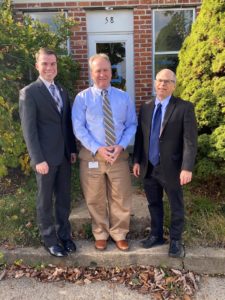Who is a member?
Our members are the local governments of Massachusetts and their elected and appointed leadership.

Gardner Mayor Michael Nicholson (left), Community Development and Planning Director Trevor Beauregard (center), and NewVue Communities Executive Director Marc Dohan stand outside a renovation project on Gardner’s Osgood Street.
A Gardner house that sat abandoned for a decade will get a second life this spring under a regional effort to acquire and renovate vacant homes in North Central Massachusetts.
The construction project on Osgood Street is Gardner’s first as part of the Liabilities to Assets program, a partnership among the Department of Housing and Community Development, Fitchburg-based community development corporation NewVue Communities, and the communities of Gardner, Athol, Clinton, Fitchburg and Leominster. The first of its kind in the state, the program seeks to stabilize neighborhoods by restoring vacant, blighted homes and promoting home ownership.
With its title problems and physical defects, the Osgood Street property would have sat vacant indefinitely if not for the program’s intervention, according to Gardner Mayor Michael Nicholson.
“The costs, legal procedures, and investment needed for a private sector developer to undertake the project alone would have been too prohibitive to even consider,” Nicholson said. “This program allows us to find new ways to spruce up neighborhoods, support home ownership, and revitalize rundown areas of the city.”
The program is in the third year of a three-year partnership with DHCD, with DHCD providing funding of up to $2.5 million annually. Program leaders said they hope the state renews the program, since proceeds from the sale of the houses aren’t enough to pay for the renovations and ensure affordability for homebuyers.
“If it were self-sustaining, the private market would be doing it,” said Marc Dohan, NewVue’s executive director.
Before undertaking projects, the partnership set up a board representing the five communities and a housing corporation under a state law (Ch. 121A), which addresses blighted areas. NewVue oversees the acquisition, renovation and sale of the homes.
The Osgood Street property is the program’s fourth project. Three more projects are lined up in Leominster, Athol and Fitchburg.
The program tries to identify neighborhoods with clusters of distressed properties. The idea is to inspire others to invest in a neighborhood when they see homes turning around, said Trevor Beauregard, Gardner’s director of community development and planning.
“Going out to these properties, and talking with the neighbors, they seem to be excited about the fact that the house will get rehabbed and put back to use,” Beauregard said. “Certainly, it’s a positive momentum for those neighborhoods, definitely.”
Liabilities to Assets can break through barriers that stymie private developers. In Gardner, no one knew who actually owned the Osgood Street house, and title problems made a normal sale impossible. The program took the property by eminent domain, said Anne Reitmayer, director of Liabilities to Assets and NewVue’s director of acquisition and finance.
The Osgood Street property requires numerous upgrades, including the removal of an unstable porch and an unsafe addition. Reitmayer said the home requires all new systems. Liabilities to Assets is committed to energy efficiency and climate resiliency, and renovations include new windows and insulation.
When the rehabilitation finishes in the spring, a property that was considered a neighborhood eyesore will be a modern-looking, single-family home with three bedrooms and one-and-a-half baths.
Completed homes are sold to buyers who earn up to 110% of area median income, and who agree to live in the homes for at least seven years. The program heavily subsidizes the projects and works to help buyers afford the homes. For instance, the Gardner renovation pricetag will exceed $400,000, but the home’s market price will likely be closer to $260,000, Reitmayer said.